Ratargul Swamp Forest: A Natural Wonder in Sylhet
Ratargul Swamp Forest is a unique natural wonder located in Sylhet, Bangladesh. It is the only freshwater swamp forest in Bangladesh, and it is home to a diverse range of flora and fauna. The forest is a UNESCO-recognized Ramsar wetland, which means that it is an important wetland area for the conservation of biological diversity.
Ratargul Swamp Forest is a popular destination for tourists, and it is easy to see why. The forest is a beautiful and peaceful place, and it offers a variety of activities for visitors to enjoy. Visitors can go kayaking, hiking, birdwatching, fishing, and camping in the forest. They can also learn about the forest’s unique ecosystem and its importance for conservation.
If you are looking for a unique and unforgettable travel experience, then Ratargul Swamp Forest is the perfect place for you. The forest is a truly special place, and it is sure to leave you with lasting memories.
In the next section, we will take a closer look at the uniqueness of Ratargul Swamp Forest. We will discuss the forest’s flora and fauna, its location, and its importance for conservation.

Check Also: Sada Pathor, Bholaganj, Sylhet
Table of Contents
The Origin of the Name Ratargul
In the greater Sylhet region, there is a traditional mat known as ‘Shital Pati’ that is made from plants. The specific plant used for crafting these mats is called Murta. Interestingly, in certain areas of Sylhet, Murta is also referred to as ‘Rata’. Furthermore, in Farsi, Urdu, and Pashto, the term ‘Gul’ translates to ‘rose’. As Farsi had a significant influence on Bangladesh’s language during the pre-colonial era, the word ‘Gul’ became widely known in the country. For instance, a rose garden or forest is commonly referred to as ‘Gulbag’. Over time, the meaning of the word ‘Gul’ has slightly transformed in colloquial usage among the general population, taking on the connotation of a ‘forest’.
Ratargul wetlands boast numerous Murta bushes. Observing this abundance, the local inhabitants christened this forest as Ratargul, signifying a forest of Murta.
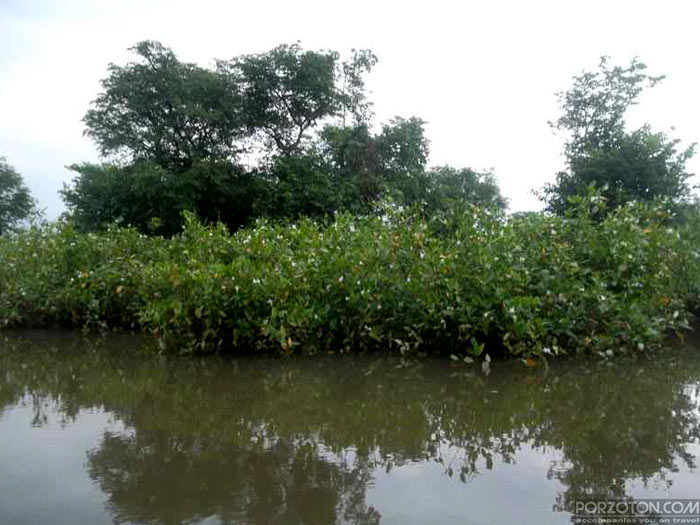
The Uniqueness of Ratargul Swamp Forest
Ratargul Swamp Forest is a unique natural wonder for several reasons. First, it is the only freshwater swamp forest in Bangladesh. This means that it is a forest that is flooded with freshwater, as opposed to saltwater. This makes the forest a unique habitat for a variety of plants and animals that are not found in other parts of Bangladesh.
Second, Ratargul Swamp Forest is home to a diverse range of flora and fauna. There are over 70 species of trees in the forest, including the banyan tree, the Barringtonia acutangula, and the Dalbergia reniformis. There are also over 200 species of plants, including the Schumannianthus dichotomus, the Hygrophila, and the Crateva religiosa. The forest is also home to a variety of animals, including monkeys, snakes, birds, and fish.
Third, Ratargul Swamp Forest is a UNESCO-recognized Ramsar wetland. This means that it is an important wetland area for the conservation of biological diversity. The forest is home to a number of endangered and threatened species, and it is an important stopover for migratory birds.
The uniqueness of Ratargul Swamp Forest makes it a valuable natural resource. The forest is important for the conservation of biodiversity, and it provides a variety of benefits for the local community. Visitors to the forest can enjoy the beauty of the natural environment, learn about the forest’s unique ecosystem, and contribute to the conservation of this important natural resource.
In the next section, we will take a closer look at the location of Ratargul Swamp Forest. We will also discuss how to get to the forest and what to expect when you visit.

The Location of Ratargul Swamp Forest
Ratargul is located at Fatehpur union of Gowainghat upazila in Sylhet district, on the south bank of the Guaine River. The distance of this forest from Sylhet city is only 26 kilometers. Ratargul can be reached in half an hour by a CNG autorickshaw from Amberkhana in the city. This is the easiest way to reach Ratargul Swamp Forest from Sylhet City.
Ratargul Swamp Forest can also be reached from Goainghat Upazila. There are regular buses from Sylhet to Goainghat. From Goainghat, the forest can be reached by rickshaw in winter and by boat in monsoon.
A good time to visit Ratargul Swamp Forest is during the dry season from November to April for those who want to see the diversity of vegetation. During this time, the water levels are lower, and it is easier to explore the forest. But if you love adventure and want to see the wild beauty and biodiversity of Ratargul then definitely visit in Monsoon.
When you visit Ratargul Swamp Forest, you can expect to see a variety of trees, plants, and animals. You can also go kayaking, hiking, birdwatching, fishing, and camping in the forest.
The forest is open to visitors from 6 am to 6 pm. The entrance fee is 50 taka for adults and 25 taka for children.
In the next section, we will take a closer look at the flora and fauna of Ratargul Swamp Forest. We will discuss the different types of trees, plants, and animals that can be found in the forest.
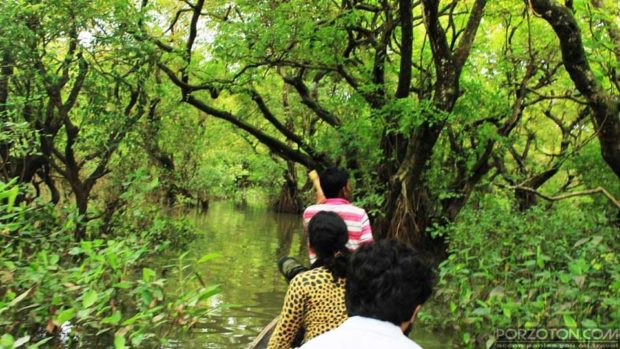
The Flora and Fauna of Ratargul Swamp Forest
Ratargul Swamp Forest is home to a diverse range of flora and fauna. There are over 70 species of trees in the forest, including the banyan tree, the Barringtonia acutangula, and the Dalbergia reniformis. There are also over 200 species of plants, including the Schumannianthus dichotomus, the Hygrophila, and the Crateva religiosa. The forest is also home to a variety of animals, including monkeys, snakes, birds, and fish.
Trees
Some of the most common trees found in Ratargul Swamp Forest include:
Banyan tree (Ficus benghalensis): This is a large, spreading tree that is known for its aerial roots. The banyan tree is a sacred tree in Hinduism, and it is often found in temples and sacred groves.
Barringtonia acutangula (Sea almond): This is a large, evergreen tree that produces white flowers and edible nuts. The sea almond tree is an important source of food for birds and other animals.
Dalbergia reniformis (Kaju tree): This is a large, deciduous tree that produces edible pods. The kaju tree is an important source of food for humans and animals.
Plants
Some of the most common plants found in Ratargul Swamp Forest include:
Schumannianthus dichotomus (Water fern): This is a large, floating fern that is found in shallow water. The water fern is an important food source for fish and other animals.
Hygrophila (Water hyacinth): This is a floating plant that is known for its bright pink flowers. The water hyacinth is an invasive species, but it is also an important food source for fish and other animals.
Crateva religiosa (Pigeonberry): This is a small, evergreen shrub that produces white flowers and edible berries. The pigeonberry shrub is an important source of food for birds and other animals.
Animals
Some of the most common animals found in Ratargul Swamp Forest include:
Monkeys (Macaca mulatta and Trachypithecus pileatus): These are social animals that live in groups. Monkeys are herbivores, and they eat fruits, leaves, and insects.
Snakes (Python molurus, Enhydris bicolor, and Dendrelaphis pictus): These are predators that eat small animals, such as frogs, fish, and birds. Snakes are an important part of the forest ecosystem, and they help to control the population of rodents and other pests.
Birds (Eurasian spoonbill, Painted stork, and Lesser whistling duck): These are migratory birds that come to Ratargul Swamp Forest to breed and feed. Birds are an important part of the forest ecosystem, and they help to pollinate plants and disperse seeds.
Fish (Batasio, Rita, and Pabda): These are freshwater fish that live in the forest’s waterways. Fish are an important source of food for humans and animals.
The flora and fauna of Ratargul Swamp Forest are a testament to the diversity of this unique natural wonder. The forest is home to a variety of plants and animals, many of which are found nowhere else in the world. Visitors to the forest can enjoy the beauty of the natural environment, learn about the forest’s unique ecosystem, and contribute to the conservation of this important natural resource.

The Activities You Can Enjoy in Ratargul Swamp Forest
Ratargul Swamp Forest is a popular destination for tourists, and there are a variety of activities that visitors can enjoy. Some of the most popular activities include:
Kayaking: This is a great way to explore the forest’s waterways and see the different plants and animals that live there.
Hiking: There are several hiking trails in the forest, which offer stunning views of the surrounding area.
Birdwatching: Ratargul Swamp Forest is a great place to see a variety of birds, including migratory birds that come to the forest to breed and feed.
Fishing: There are several spots in the forest where you can fish for freshwater fish.
Camping: There are several campsites in the forest, where you can enjoy the peace and quiet of nature.
Other activities:
Nature study: Visitors can learn about the forest’s unique ecosystem and its importance for conservation.
Photography: The forest is a beautiful place to take photos, and there are many opportunities to capture stunning images of the plants, animals, and waterways.
Relaxation: Visitors can simply relax and enjoy the peace and quiet of the forest.
The activities that you can enjoy in Ratargul Swamp Forest will depend on your interests and preferences. However, there is something for everyone in this unique natural wonder.
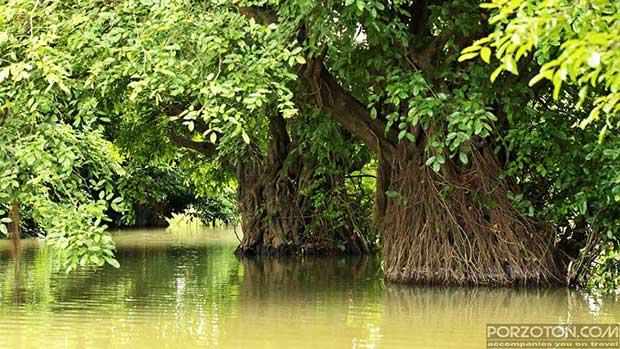
Conservation of Ratargul Swamp Forest
Ratargul Swamp Forest is a valuable natural resource, and it is important to conserve it for future generations. There are a number of threats to the forest, including:
- Deforestation: The forest is under threat from deforestation, as trees are being cut down for timber and fuelwood.
- Pollution: The forest is also under threat from pollution, as agricultural runoff and industrial waste are polluting the waterways.
- Invasive species: The forest is also threatened by invasive species, such as the water hyacinth, which can crowd out native plants and animals.
There are a number of things that can be done to conserve Ratargul Swamp Forest, including:
- Enforcing laws against deforestation: The government should enforce laws against deforestation to protect the forest.
- Educating the public: The public should be educated about the importance of the forest and the threats it faces.
- Reducing pollution: The government should work to reduce pollution in the waterways that surround the forest.
- Controlling invasive species: Invasive species should be controlled to prevent them from harming the forest ecosystem.
The conservation of Ratargul Swamp Forest is important for the future of this unique natural wonder. By working together, we can protect this important natural resource for future generations.
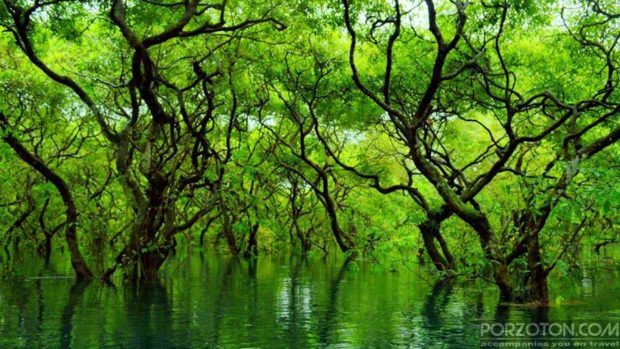
Best Time to Visit Ratargul Swamp Forest
The best time to visit Ratargul Swamp Forest is during the dry season, from November to April. During this time, the water levels are lower, and it is easier to explore the forest. However, the forest is also beautiful during the monsoon season, from May to October. The water levels are higher during this time, and there are more birds and other animals to see.
Here are some of the pros and cons of visiting Ratargul Swamp Forest during each season:
Dry season (November to April)
Pros:
- The water levels are lower, making it easier to explore the forest.
- There are fewer mosquitoes.
- The weather is generally pleasant.
Cons:
- Some trails may be closed due to low water levels.
- The forest may be less lush and green.
Monsoon season (May to October)
Pros:
- The forest is lush and green.
- There are more birds and other animals to see.
- The water levels are higher, making it easier to go kayaking and fishing.
Cons:
- The weather can be hot and humid.
- There are more mosquitoes.
- Some trails may be closed due to high water levels.
Ultimately, the best time to visit Ratargul Swamp Forest depends on your personal preferences. If you want to explore the forest and see a variety of plants and animals, the dry season is a good time to visit. If you want to experience the lushness of the forest and see more birds and other animals, the monsoon season is a good time to visit.
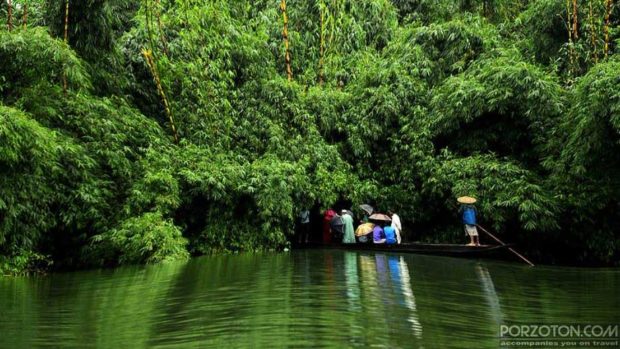
Capturing Memories: Photography Tips for Ratargul Swamp Forest
Ratargul Swamp Forest is a beautiful place to take photos, and there are many opportunities to capture stunning images of the plants, animals, and waterways. Here are some photography tips for capturing the best memories of your visit to Ratargul Swamp Forest:
- Bring a good camera: A DSLR or mirrorless camera with a wide-angle lens will be ideal for capturing the beauty of the forest.
- Use natural light: The best time to take photos is early in the morning or late in the afternoon, when the light is soft and diffused.
- Be patient: The forest is a dynamic place, and the light and weather conditions can change quickly. Be patient and wait for the perfect shot.
- Get close: Don’t be afraid to get close to the plants and animals to capture their details.
- Experiment: Try different angles and compositions to find the most interesting shots.
- Have fun: Ratargul Swamp Forest is a beautiful place, so enjoy yourself and take your time capturing its beauty.
Here are some additional photography tips that are specific to Ratargul Swamp Forest:
- Be aware of the water levels: The water levels in the forest can change depending on the season. Be sure to check the water levels before you go kayaking or fishing.
- Be aware of the wildlife: There are a variety of animals in the forest, including monkeys, snakes, and birds. Be sure to respect the wildlife and do not disturb them.
- Be respectful of the environment: Ratargul Swamp Forest is a fragile ecosystem. Be sure to leave no trace of your visit.
I hope these photography tips help you capture the beauty of Ratargul Swamp Forest.
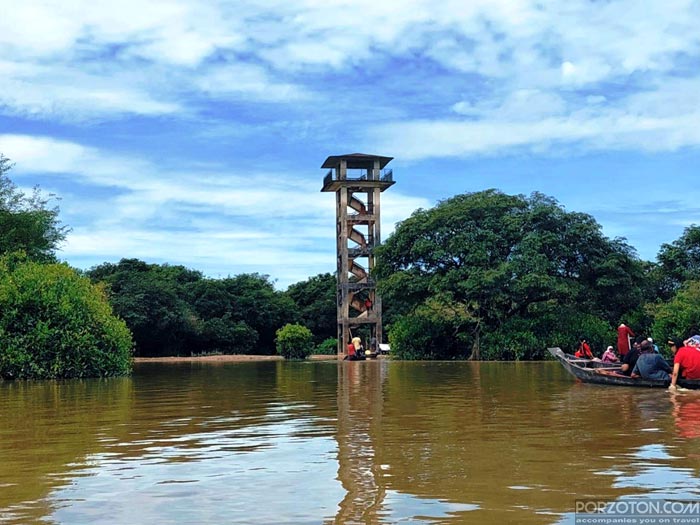
Tips for Visiting Ratargul Swamp Forest
What to pack:
- Comfortable shoes: You will be doing a lot of walking in the forest, so be sure to wear comfortable shoes.
- Insect repellent: There are a lot of mosquitoes in the forest, so be sure to bring insect repellent.
- Sun hat: The sun can be strong in the forest, so be sure to bring a sun hat.
- Water bottle: You will need to stay hydrated, so be sure to bring a water bottle.
- Snacks: There are no food or drink stalls in the forest, so be sure to bring snacks.
- Camera: You will want to capture your memories of the forest, so be sure to bring a camera.
What to wear:
- Comfortable clothes that you can move around in.
- Long pants and sleeves to protect yourself from insects and the sun.
- Shoes that you can get wet, if you plan on going kayaking or fishing.
What to expect:
- A beautiful and unique natural environment.
- A variety of plants and animals, including monkeys, snakes, and birds.
- The opportunity to go kayaking, hiking, birdwatching, fishing, and camping.
- A chance to learn about the forest’s unique ecosystem and its importance for conservation.
Best time of year to visit:
- The dry season (November to April) is a good time to visit if you want to explore the forest and see a variety of plants and animals.
- The monsoon season (May to October) is a good time to visit if you want to experience the lushness of the forest and see more birds and other animals.
How to avoid the crowds:
- Visit during the off-season.
- Visit early in the morning or late in the afternoon.
- Visit on weekdays, rather than weekends.
I hope these tips help you plan your visit to Ratargul Swamp Forest.

How to go to Ratargul
From Dhaka to Sylhet
If you would like to travel to Ratargul, you’ve to go to Sylhet city first. You can go directly to Sylhet from Dhaka by road, train and air. Sylhet can also be reached from Chittagong directly.
A total of 5 trains leave Dhaka’s Kamalapur railway station for Sylhet every day of the week. Among them, four are intercity trains and one mail train. However, some trains have off days. The following article will suffice for you to know more about Dhaka to Sylhet train schedule and ticket price: Dhaka to Sylhet Train Schedule 2020.
Buses leave Sylhet from Dhaka’s Fakirapul, Saidabad and Mohakhali bus stations. AC buses of Green Line Paribahan, Saudia S Alam Paribahan, Shyamali Paribahan and Ena Paribahan run on this route. Rent 800 to 1100 taka. Besides, non-AC buses of Shyamali Paribahan, Hanif Enterprise, Unique Service and Ena Paribahan go to Sylhet, fare is 400 to 470 taka. The buses of Ena Paribahan go to Sylhet via Tongi Ghorashal. Read Dhaka to Sylhet Bus: Ticket Price & Contacts for more details. The article includes the amount of fare and the phone number of each bus counter.
From Sylhet to Ratargul
From the Amberkhana or Mazar Gate in Sylhet, you can reach Motorghat near Ratargul in half an hour by CNG autorickshaw. If you reserve a CNG autorickshaw, you’ll have to pay 300 to 400 taka. The CNG autorickshaw will drop you off at Motorghat. You will find small boats at Motorgaht. These boats take you around the entire Swamp Forest Ratargul. You can rent a boat for 400 to 800 taka to explore the whole forest.
Ratargul can also be reached from Sylhet Amberkhana via Gowainghat. In that case you’ve to take a CNG autorickshaw from Sylhet city to Gowainghat Upazila Sadar. The rent will be 450 to 500 taka. Trawlers are available from there. If you reserve a trawler from Goainghat to Ratargul, the fare will be 700 to 800 taka. Then you’ve to reach Ratargul forest and take a small boat.
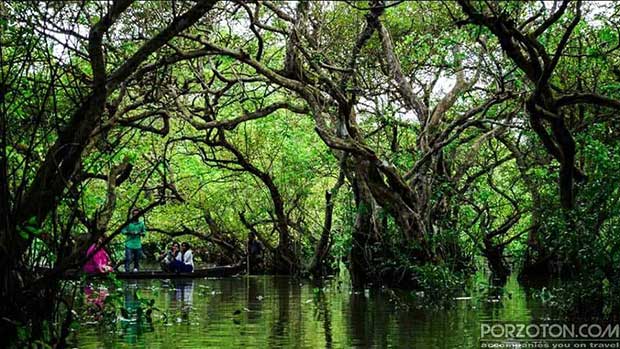
Conclusion
Ratargul Swamp Forest is a unique natural wonder that is worth visiting. The forest is home to a variety of plants and animals, and it offers a variety of activities for visitors to enjoy. Whether you are interested in kayaking, hiking, birdwatching, fishing, or simply relaxing in nature, Ratargul Swamp Forest is a great place to visit.
In addition to its beauty and diversity, Ratargul Swamp Forest is also an important natural resource. The forest helps to regulate the water cycle, provide a habitat for wildlife, and protect the environment. By visiting Ratargul Swamp Forest, you can help to support the conservation of this important natural resource.
I hope you have enjoyed reading about Ratargul Swamp Forest. If you are looking for a unique and unforgettable travel experience, then I encourage you to visit this beautiful forest.
Here are some of the reasons why you should visit Ratargul Swamp Forest:
- It is a unique natural wonder.
- It is home to a variety of plants and animals.
- It offers a variety of activities for visitors to enjoy.
- It is an important natural resource.
- It is a beautiful and peaceful place to visit.
I hope you will consider visiting Ratargul Swamp Forest on your next trip to Bangladesh.

Sunamganj: Tanguar Haor
Places of Interest Nearby
Lalakhal is very close to Ratargul Swamp Forest, which is called the Nile of Bangla. Malnicherra Tea Estate, the oldest and largest tea garden in the subcontinent, is within one kilometer of Sylhet city. And Hazrat Shahjalal (Ra.) Mazar is at a walking distance to the south from Amberkhana.
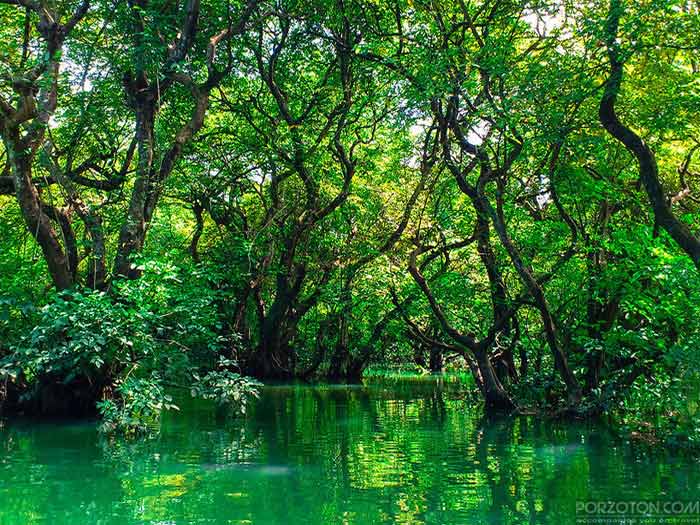
FAQs on Ratargul Swamp Forest
Ratargul Swamp Forest is famous for a few reasons. First, it is the only freshwater swamp forest in Bangladesh and one of the few in the world. Second, it is home to a diverse range of flora and fauna, including many endangered species. Third, it is a beautiful and tranquil place to visit, especially during the monsoon season when the forest is submerged in water.
The Ratargul Swamp Forest is home to a variety of trees that are important for the local community and for the environment. These trees provide a variety of benefits, such as timber, food, shade, and medicinal properties. The most common tree in the forest is the Koroch tree, which is known for its zigzag branches. Other important trees include the Hijal tree, the Banyan tree, the Arjun tree, and the Chatim tree.
The Ratargul Swamp Forest is home to a diverse range of animals, including monkeys, snakes, birds, and fish. Monkeys are the most common animals in the forest, and they are social animals that live in groups. Snakes are predators that eat small animals, such as frogs, fish, and birds. Birds are important for the forest ecosystem, as they help to control the population of insects. Fish are an important source of food for the local community.
Swamp forests are characterized by wet and muddy surfaces, tall trees with stilt roots, and diverse plant and animal life. They are found in areas with poor drainage and high water tables. Swamp forests are important habitats for a variety of species, including fish, birds, and mammals.
The exact number of swamp forests in the world is unknown, but there are thought to be hundreds or even thousands of them. Swamp forests are found in all parts of the world, but they are most common in tropical and subtropical regions. Some of the most famous swamp forests include the Amazon River floodplain, the Pantanal in Brazil, the Okavango Delta in Botswana, and the Sundarbans in Bangladesh and India.
There are about 22 freshwater swamp forests in the world. They are found in Asia, Africa, and South America. Some of the most famous freshwater swamp forests include: Ratargul Swamp Forest in Bangladesh, Peninsular Malaysian peat swamp forests in Malaysia and Thailand, Chao Phraya freshwater swamp forests in Thailand, Irrawaddy freshwater swamp forests in Myanmar, Borneo peat swamp forests in Brunei, Indonesia, and Malaysia, Okavango Delta in Botswana, Mamiraua Sustainable Development Reserve in Brazil, Pantanal in Brazil, and Amazon River floodplain in South America.
The most famous swamp in the world is the Okavango Delta, which is located in Botswana. The Okavango Delta is a UNESCO World Heritage Site and is known for its lush vegetation, diverse wildlife, and beautiful scenery. The delta is home to over 1,000 species of plants and animals, including elephants, lions, giraffes, and zebras. The Okavango Delta is also a popular tourist destination, and is known for its safaris, boat rides, and bird watching.
